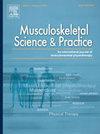The relationship between radiological OA severity or body weight and outcomes following a structured education and exercise therapy program (GLA:D®) for people with knee osteoarthritis
IF 2.2
3区 医学
Q1 REHABILITATION
引用次数: 0
Abstract
Background
Clinicians may presume people with higher bodyweight or greater OA severity do not respond to exercise therapy for knee osteoarthritis (OA), but few studies have examined this.
Objective
To examine the relationship between radiographical OA severity or bodyweight and pain and functional outcomes following a structured education and exercise therapy program (Good Life with OsteoArthritis from Denmark: GLA:D®).
Methods
33 participants with knee OA were assessed at baseline and week 8 following GLA:D®. Outcomes were pain (Visual analogue scale (VAS) 0–100), Knee Injury and Osteoarthritis Outcome Score-12 (KOOS-12 total), 40 m-fast-paced walk and 30-s chair stand. Multilevel models were used to define the severity of OA in medial, lateral and patellofemoral compartments using the Kellgren-Lawrence (KL) system and to examine the relationship between compartment severity, bodyweight and outcomes.
Results
No meaningful relationships between bodyweight and response to GLA:D® were found for any outcome measures. Greater medial OA compartment severity was related to less improvement in pain, KOOS-12 and chair stand repetitions. However, all levels of lateral compartment severity had similar improvements, and greater patellofemoral compartment severity was related to more improvement for KOOS-12 and pain.
Conclusion
Bodyweight may have little influence on a person's response to a structured education and exercise therapy program. While people with greater medial compartment severity were less likely to improve following the program, OA severity in the PF and lateral compartments was not a barrier to improvement.
针对膝关节骨性关节炎患者的结构化教育和运动疗法计划 (GLA:D®) 的放射学 OA 严重程度或体重与疗效之间的关系
背景临床医生可能会认为体重较重或骨关节炎严重程度较高的人不会对膝关节骨关节炎(OA)运动疗法产生反应,但很少有研究对此进行研究。方法33名膝关节OA患者在基线和GLA:D®后第8周接受评估。结果包括疼痛(视觉模拟量表(VAS)0-100)、膝关节损伤和骨关节炎结果评分-12(KOOS-12总分)、40米快步行走和30秒椅子站立。使用Kellgren-Lawrence(KL)系统的多层次模型来定义内侧、外侧和髌骨股骨室的OA严重程度,并检查室严重程度、体重和结果之间的关系。结果在任何结果测量中,均未发现体重与对GLA:D®的反应之间存在有意义的关系。OA内侧隔间严重程度越高,疼痛、KOOS-12和椅子站立重复次数的改善程度越低。结论:体重可能对一个人对结构化教育和运动治疗计划的反应影响不大。虽然内侧间室严重程度越高的人在接受该计划后病情改善的可能性越小,但髌股关节和外侧间室的 OA 严重程度并不是病情改善的障碍。
本文章由计算机程序翻译,如有差异,请以英文原文为准。
求助全文
约1分钟内获得全文
求助全文
来源期刊

Musculoskeletal Science and Practice
Health Professions-Physical Therapy, Sports Therapy and Rehabilitation
CiteScore
4.10
自引率
8.70%
发文量
152
审稿时长
48 days
期刊介绍:
Musculoskeletal Science & Practice, international journal of musculoskeletal physiotherapy, is a peer-reviewed international journal (previously Manual Therapy), publishing high quality original research, review and Masterclass articles that contribute to improving the clinical understanding of appropriate care processes for musculoskeletal disorders. The journal publishes articles that influence or add to the body of evidence on diagnostic and therapeutic processes, patient centered care, guidelines for musculoskeletal therapeutics and theoretical models that support developments in assessment, diagnosis, clinical reasoning and interventions.
 求助内容:
求助内容: 应助结果提醒方式:
应助结果提醒方式:


